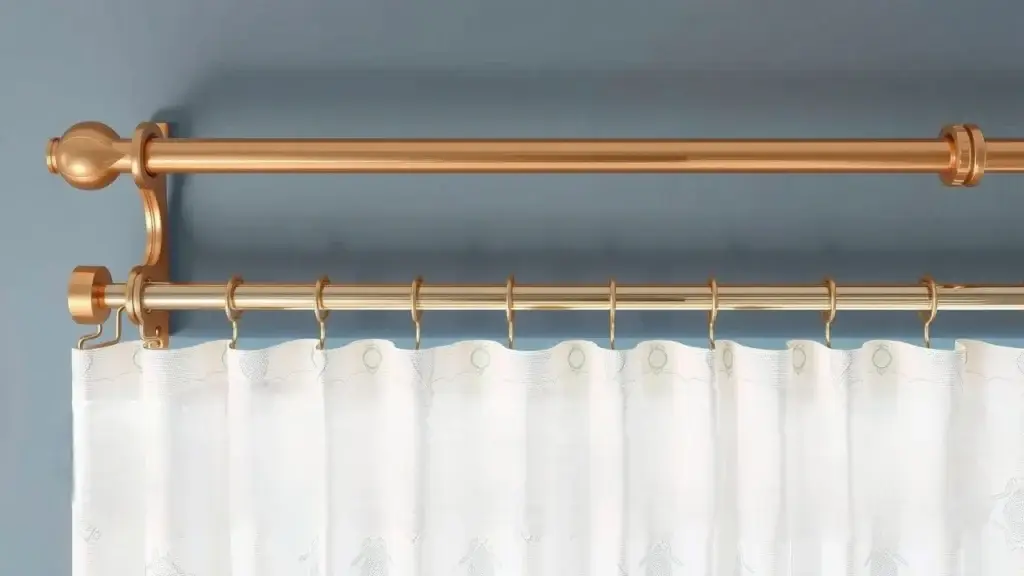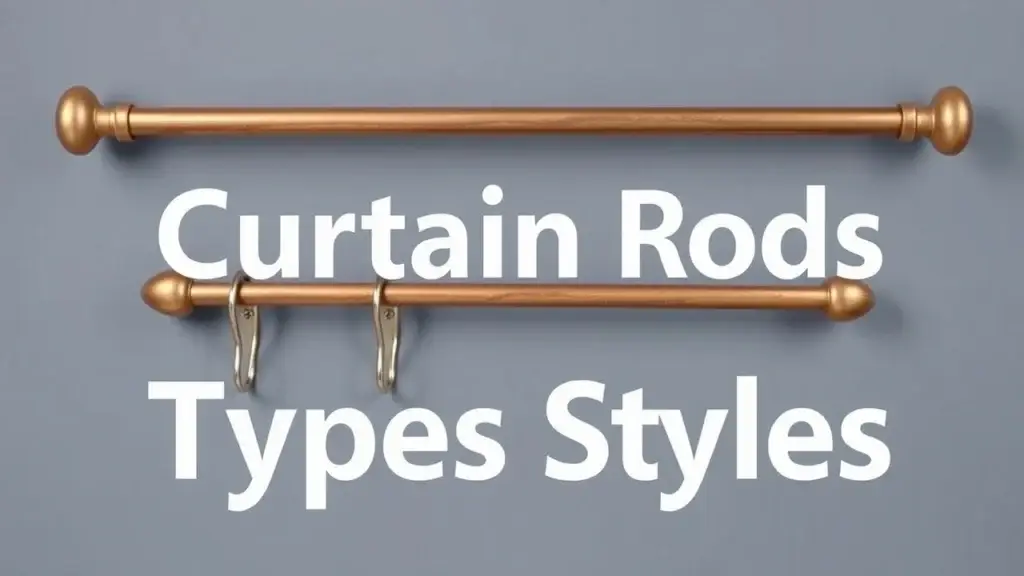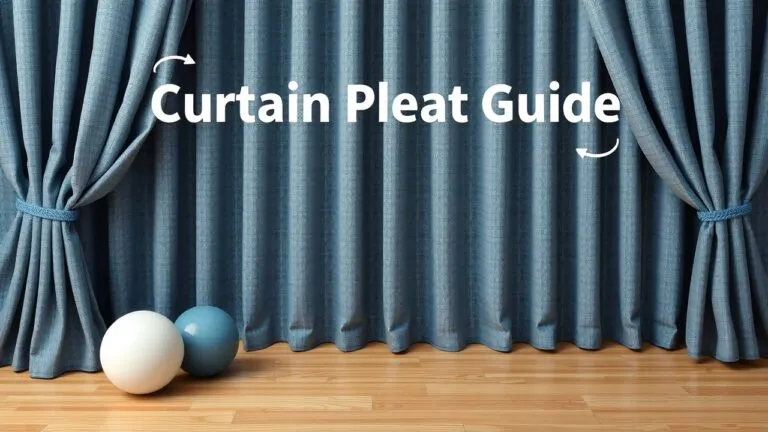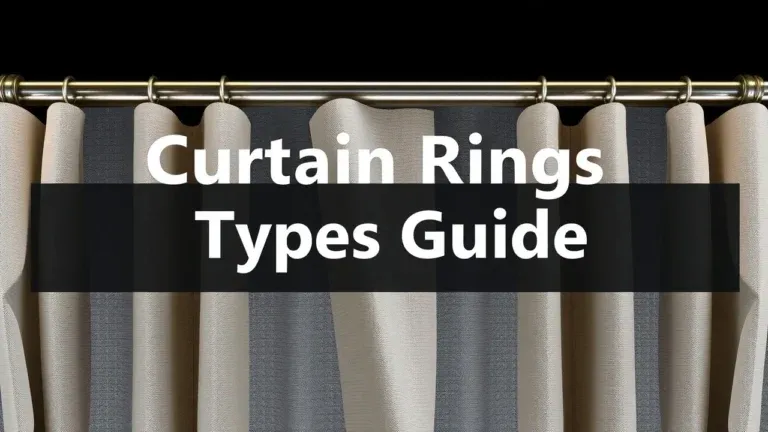This guide covers all types of curtain rails, from simple rods to complex tracks, helping you choose the perfect fit for your windows and home decor.
What Are Curtain Rails?

Curtain rails serve a specific purpose. They create a track system to hold and move curtains. This differs from curtain rods, which are solid poles attached with brackets. Tracks allow gliders or hooks to attach the fabric directly. This makes it simpler to move heavier fabrics without sagging. Curtain rails are important for hanging curtains or drapes in homes and businesses. They let curtains slide easily open and shut. Unlike regular curtain rods that sit above, curtain tracks can be mounted on walls or ceilings. This gives you more options for design and use.
Why Choosing the Right Curtain Rail Matters?
Picking the right curtain rail affects how well your curtains function and how they look in your space. Good choices help curtains slide smoothly, while also adding style to your room.
Durability matters too! Different materials can affect how long your rail lasts with different weights of curtains. Heavy-duty options may be better for thick drapes or large windows. Understanding the weight capacity can help prevent problems like bending or breaking from heavy curtains.
Overview of Types Covered in This Guide
This guide looks at several types of curtain rails designed for various needs:
- Single Track Systems: Best for standard windows needing one layer of fabric.
- Double Track Systems: Let you layer two sets of curtains, like sheer panels behind heavier drapes.
- Triple Track Systems: Offer even more layering with three sets of fabric; great for complex designs.
- Bay Window Rails: Made for bay windows, allowing smooth operation at different angles.
- Ceiling-Mounted Options: These save vertical space and hide hardware for a clean look.
Understanding these types will help you make better choices about what fits your home decor style—whether you lean towards modern looks or prefer traditional charm.
Types of Curtain Rails Explained
Choosing the right curtain rails for your home is super important. Different types of curtain rails have unique features that fit various styles and needs. Here, we’ll look at three main categories: single track rails, double track systems, and triple track systems.
Single Track Rails
Single track curtain rails are simple to install and made mainly for lightweight curtains. These tracks have one rail where curtains slide back and forth using hooks or clips. They come in materials like metal or plastic, which makes them affordable and easy to find.
Best use cases for single-track systems are in rooms that need simple designs. You might use sheer curtains in a living room or lightweight drapes in a bedroom. They let in light while keeping things neat.
Pros:
- Affordable price point
- Easy to install
- Available in many materials
Cons:
- Limited versatility compared to other systems
- Lower weight capacity; not great for heavy fabrics
Double Track Systems
Double track systems let you layer two sets of curtains on one window. This feature helps control light by mixing sheer panels with blackout drapes or heavier fabrics. The top rail holds the sheer curtain while the bottom rail supports thicker drapery.
These setups are perfect for rooms where you want to manage light levels, like bedrooms needing darkness at night but allowing soft morning light during the day.
You can find visual examples across many interior design sites showing how double tracks frame windows nicely while giving you functional flexibility with layered looks.
Triple Track Systems
If you’re looking for more options, triple track systems allow multiple layers of curtains at once. You can combine sheers, blackout options, and valances all together nicely.
This system works great for large windows or spaces that need stylish yet functional treatments. It offers lots of customization while making any room look better.
Visual examples show how these setups can change regular windows into standout features in modern homes while keeping things practical through effective layering techniques.
Specialized Curtain Rail Types
Bay Window Rails
Bay window curtain rails are made to fit the unique shapes of bay windows. They can handle different designs, creating a smooth look that boosts your room’s style. You can get these rails in custom lengths and curves, so they match your window’s size perfectly.
Installation Considerations:
Putting up bay window rails can be tricky because they aren’t straight. It’s super important to measure carefully before buying or cutting materials. If you choose corner curtain tracks or heavy-duty options, you might need extra support brackets to keep everything stable and avoid sagging.
Pros & Cons:
Pros:
- Can be customized to fit your specific window shapes.
- Looks great by framing the bay area nicely.
- Available for lightweight curtains or heavy drapes with the right carriers.
Cons:
- More complicated to install than regular straight rods.
- Might need a professional if you’re not handy.
- Usually costs more than standard curtain rods due to custom needs.
Ceiling-Mounted Rails
Ceiling-mounted rails give a modern look for hanging curtains straight from the ceiling. This option works well in minimalist spaces where you want clean lines and a neat appearance.
Suitable Scenarios:
Ceiling-mounted options are great for high ceilings or if you want to make a small room feel taller. They also let you use motorized systems, which are handy for hard-to-reach spots since you can control them with a remote.
Pros & Cons:
Pros:
- Saves floor space by being mounted on the ceiling.
- Creates a stylish, modern look that fits many decor styles.
- Works well with different types of curtains, like sheer fabrics that let light in nicely.
Cons:
- Installing can be tricky; it requires precise measurements and drilling into the ceiling.
- Once they’re up, changing styles may mean taking everything down and starting over.
Additional Subtopics
- Installation Techniques:For both bay window and ceiling-mounted rail systems, gather tools like drills, screws, brackets, and measuring tape first. Measure accurately before marking drill points on walls or ceilings based on your chosen design. Stick closely to the manufacturer’s instructions during installation for best results.
- Visual Examples:Showcasing images of successful installations can inspire readers and demonstrate how these special rail systems can enhance home interiors effectively.
- Compatibility with Different Curtains:Think about the weight of the curtains when picking ones for these special rail systems—sheer curtains go well with lighter tracks while blackout drapes may need heavy-duty carriers to prevent sagging over time.
- Maintenance Tips:Regularly check that mounting hardware is tight after installation; this helps maintain smooth operation over time and extends lifespan against wear-and-tear from frequent use.
- Customization Options:Many manufacturers provide customizable features like different color finishes or decorative end caps that boost both function and style tailored to individual tastes in home aesthetics!
- Common Issues Encountered:To fix problems like noisy operations, try lubricating track mechanisms regularly while addressing sagging might mean reinforcing supports along longer spans between brackets!
Curtain Rods: A Separate Approach
Description: Distinguishing curtain rods from rails; materials, styles.
Curtain rods are different from curtain rails, even though they both hold curtains. Rods are poles that you can attach to your walls. They usually use rings or clips to hold the curtains in place. There are several types of curtain rods made from different materials:
- Metal Curtain Rods: Strong and modern-looking, these rods often have decorative ends called finials that make them stylish.
- Wood Curtain Rods: These give a warm and classic vibe, perfect for traditional styles. They may need a bit more care than metal ones.
- Plastic Curtain Rods: Lightweight and budget-friendly, these are good for lighter curtains but might not hold heavier ones well.
- Decorative Curtain Rods: These rods come with fancy designs that add character to your window treatments.
Modern curtain rods often have features like adjustable lengths or built-in brackets. This makes installation easier.
Use Cases: Traditional or decorative looks.
When picking window treatments for your home decor, think about the look you want. If you like a traditional style, wooden or ornate metal curtain rods pair well with heavy fabrics like velvet. Adding decorative finials can give an elegant touch.
For a modern look, sleek metal curtain rods with light fabrics create an open feel without crowding the space. You can mix different curtains, like sheer panels over solid ones, to add style while keeping things cohesive in your home.
Choosing the Right Curtain Rail: A Decision-Making Guide

Choosing the right curtain rail is a key step to improving how your home looks and feels. With so many options available, knowing how to choose curtain tracks can really help you make the best choice for your windows.
Factors to Consider
When deciding on curtain rails, there are some important things to think about:
- Window Size and Shape: Measure your windows. Their size and shape will affect what type of curtain rail you should use.
- Curtain Weight and Style: Think about whether you want lightweight curtains or heavy drapes. This matters because some rails are made for lighter or heavier fabrics.
- Aesthetics: The design of the curtain rail should match your home’s style. Whether it’s modern or traditional, you’ll find options that fit well.
- Budget: Set a budget for both the product and any installation costs. There are many budget-friendly curtain rods as well as more expensive choices.
Step-by-Step Selection Process
To help you pick the right curtain rails, follow these simple steps:
- Identify Your Needs:
- Do you want functionality, like blackout curtains, or do you want something decorative?
- Measure Accurately:
- Take careful measurements to make sure your chosen system fits well in the window space.
- Evaluate Available Options:
- Look at single track systems compared to double or triple tracks. Pick what works best for your space and style.
Additional Tips
For special cases like unique window shapes:
- Consider Custom Solutions: If your windows are not standard, like bay or arched designs, custom options may be necessary.
- Consult Professionals: If you’re unsure about how to measure or install them, it might be wise to get professional help.
By following this guide, you’ll be better prepared to select curtain rails that enhance both function and style in your home. Understanding these factors will help you make smart choices when it comes to products related to curtains while keeping a cohesive look throughout your space.
Curtain Rail Installation, Maintenance, and Troubleshooting
Accurate Window Measurement Techniques
Getting the right measurements for your windows is super important when you’re looking at curtain rail installations. First, measure the width of your window frame at three spots: the top, middle, and bottom. Pick the widest number you find. This way, your curtains will cover everything nicely. For height, start where you want the curtain to hang (usually above the window) and measure down to where you want them to stop—like just above or below the sill.
When measuring for curtain tracks, think about how far you want them to stick out beyond the window edges. If you’re using heavy drapes, having extra space helps when you pull them back. Always double-check those numbers before buying your materials; a little mistake can cause big issues during setup.
Choosing Appropriate Fasteners
Picking the right fasteners depends on what type of walls you have and how heavy your curtains are. If you’re dealing with drywall, toggle bolts are great since they give strong support but need bigger holes. If you can mount into wooden studs, wood screws are solid and won’t damage as much.
For heavier curtains or robust rails, use brackets that are built to hold weight. Make sure all hardware looks good together and fits well with your rail choice—think about whether you prefer a classic rod or a more modern track system.
Hanging Curtains Evenly
Hanging your curtains evenly is key for a tidy look and smooth operation. Here’s how to do it:
- Use a Level: Mark where to put brackets or hooks based on your measurements.
- Double-Check Your Numbers: Make sure everything lines up before securing anything.
- Install Brackets First: Attach them according to instructions for rods or tracks.
- Hang Curtains Carefully: Adjust as needed so they fall straight without twisting.
Taking time to install properly saves frustration later from having to fix uneven curtains.
Cleaning and Maintenance
To keep your curtain rails and tracks looking good and working well, regular cleaning is essential:
- Dust Weekly: Use a soft cloth or duster.
- Deep Clean Occasionally: Wipe down metal parts with mild soap and water; make sure to dry them off well.
For fabric-covered areas in some track systems:
- Vacuum gently using an upholstery attachment every few months.
Stay away from harsh chemicals that might damage metal parts; stick with gentle cleaners suitable for everyday use.
Common Problems & Solutions
Over time, curtain rail systems can run into some common issues:
- Sagging Curtains: This usually happens if there isn’t enough support; check if you need more brackets for longer spans.
- Noisy Operation in Tracks: Dust buildup can cause problems—regular cleaning should help this a lot.
- Misalignment Issues During Installation: Re-check your initial measurements against where everything was installed; small tweaks often fix alignment problems without starting over completely.
By understanding these aspects of installing and maintaining different types of curtain rails, homeowners can enjoy beautiful spaces while keeping functionality in mind!
Frequently Asked Questions (FAQs)
What are the main differences between curtain tracks and rods?
Curtain tracks offer a gliding mechanism. They allow curtains to move smoothly along a track. Curtain rods are solid poles, typically requiring rings or hooks for hanging. Tracks can handle heavier fabrics, while rods may be limited in weight capacity.
How do I install a ceiling-mounted curtain track?
To install a ceiling-mounted curtain track, measure your window width accurately. Securely mark drill points for brackets. Use appropriate anchors for your ceiling type. Follow the manufacturer’s instructions closely to ensure proper installation.
Can I use wavefold or ripplefold draperies with curtain tracks?
Yes, wavefold and ripplefold draperies work well with curtain tracks. These styles create soft, elegant folds that glide easily on the track system, enhancing visual appeal and functionality.
What is the weight capacity of heavy-duty curtain tracks?
Heavy-duty curtain tracks generally support 20 pounds per linear foot or more. They are ideal for thick drapes like velvet or lined curtains, ensuring stability over time.
Are there decorative options available for curtain tracks?
Yes, many decorative options exist for curtain tracks. You can find stylish end caps and various finishes that enhance aesthetics while maintaining function.
Additional Keywords Related to Curtain Rails
Types of Curtain Track Systems
- Single track systems for standard windows
- Double track systems for layering curtains
- Triple track systems for maximum flexibility
Curtain Track Accessories
- Eyelet carriers for easy sliding
- Hook carriers for different fabric weights
- Grommet curtains provide a modern look
Curtain Track Maintenance Tips
- Regularly clean dust from rails
- Lubricate moving parts to prevent noise
- Tighten screws to avoid sagging
Choosing the Right Curtain Rail Materials
- Aluminum tracks are lightweight yet durable
- Steel tracks offer added strength
- Plastic options are budget-friendly
Custom Curtain Tracks
- Tailor lengths and shapes to fit unique windows
- Consider bespoke solutions for non-standard designs
Related Topics
- Types of curtain track systems
- Types of curtain rod materials
- Types of curtain carriers
- Types of window treatments
- Types of curtain header styles
- Types of fasteners for curtain rails
- Types of curtain cleaning methods
- Types of curtain installation techniques



Types of Curtain Rails: A Complete Guide